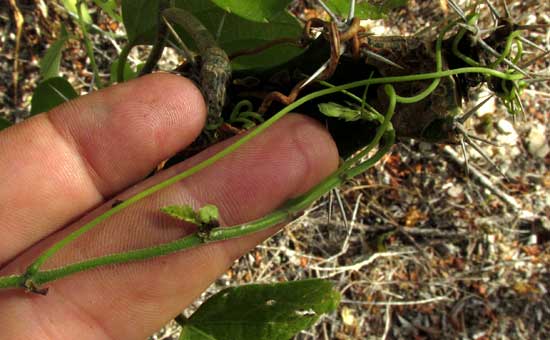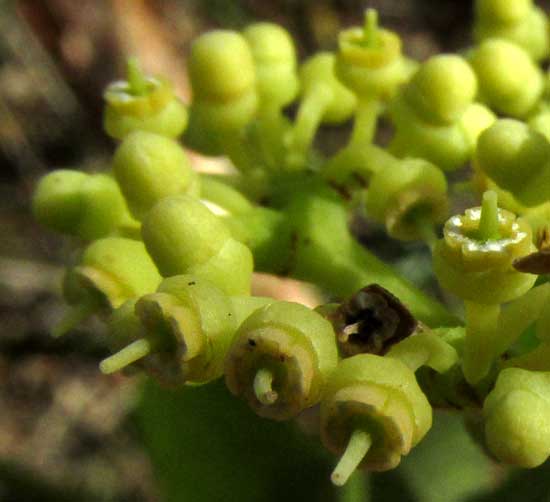from the May 29, 2016 Newsletter issued from Hacienda Chichen Resort beside Chichén Itzá Ruins; limestone bedrock; elevation ~39m (~128ft), N20.675°, W88.569°; central Yucatán state, MÉXICO
"TROPICAL GRAPEVINE" FLOWERING
At the trail's edge through the woods a woody vine, or liana, bore fresh, new leaves looking a bit like grapevine leaves, long tendrils, and clusters of yellowish-green flowers, as shown below:

Some vines produce branched tendrils while others have unbranched ones, or no tendrils at all. Our vine had unbranched ones, as shown below:

A close-up look revealed flowers typical of Grapevine Family, the Vitaceae, shown below:

In the above picture you see flowers in two stages of development, both typically seen in the Grapevine Family. The blossoms up front with stubby items protruding beyond the discs -- they're the ovaries' styles -- have lost their corollas. Farther back in the picture there are flowers with green domes covering their styles. The domes are the blossoms' petals, each petal's sides adhering to the sides of the neighboring petal, so that altogether the stuck-together petals form the dome. In some grapevine species the domes fall off as a unit, but in others the petals break away from one another and open outward. On the Internet I find many pictures showing flowers with separate petals, but you can see that all ours appear to have lost a dome of adhering petals. I wonder whether under our present extremely hot, dry conditions the petals might not remain together, though in other times they normally open?
This is CISSUS VERTICILLATA, sometimes in English known as the Seasonvine. It's a very widely distributed species, from the US Southeast south through Mexico, Central America and the Caribbean throughout most of South America. Covering such a large area, the vine varies a great deal in appearance. Back in 2009 we got a picture of the fruits, or grapes, shown at www.backyardnature.net/n/09/091115ci.jpg
The fruits are too tough and with too little flesh to be eaten by humans. The literature does mention several medicinal uses, however, for instance for respiratory problems and abscesses. In Brazil, decoctions of the vine's leaves are taken widely as a remedy for diabetes. Its common name there translates to vegetable-insulin.
from the May 29, 2016 Newsletter issued from Hacienda Chichen Resort beside Chichén Itzá Ruins; limestone bedrock; elevation ~39m (~128ft), N20.675°, W88.569°; central Yucatán state, MÉXICO
"TROPICAL GRAPE"
Here and there along roads and in the woods a fairly woody vine, or liana, with shiny, leathery leaves and longish clusters of pea-sized, grapelike fruits climbs high into trees. At this season its fruits still are mostly hard and green but a few are maturing into succulent, black "grapes," as shown below:


Some of those aerial roots, having been cut as high as a machete could reach, now have sprouted new growing tips and continue their journey earthward. In former times such aerial roots did the service of rope. The US Southeast's wild Muscadine grapes issue similar aerial roots, but those are not nearly as thick and strong as these.
Various parts of Cissus vines are medicinal. My Maya friend José says that leaf juice is especially good against "bad winds," "vientos malos," that blow on you and cause your neck to twist and hurt. A technical paper on the Internet looks at the effects of leaf alcohol extracts of Cissus sicyoides on pregnant rats because the vine in Brazil, where it is an invasive from this part of the world, is used extensively as a medicine. Brazilians sometimes call the plant "Insulina Vegetal," or "Vegetable Insulin," the paper says, and use extracts from it not only for diabetes but also as a diuretic, an anti-inflammatory and against epilepsy. Other studies demonstrate a "vasoconstrictor effect on guinea-pig aorta rings." Maximino Martinez's Las Plantas Medicinales de Mexico reports that in Mexico alcohol extracts of it have been used against rheumatism, which I suppose to be arthritis, and for ulcers and bruises. Beating the leaves in water even produces suds you can wash with.
Not all news about the health effects of Cissus sicyoides extracts is good, however. One study showed that a tea made of the leaves increased chromosomal damage in bone marrow cells. The study on the Internet I found reports that extracts caused pregnant rats to abort.